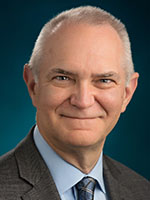
By Linking Competencies, Milestones and EPAs
The transition to competency-based medical education (CBME) presents an opportunity for the American Board of Medical Specialties (ABMS) community and its stakeholders to design and build a seamless continuum of learning and assessment in medicine.

One of the responsibilities of certifying boards is to focus on the entire continuum of education for physicians and physicians in training, noted David Turner, MD, Vice President of CBME at the American Board of Pediatrics (ABP). “The education continuum includes a number of transitions as one progresses from undergraduate medical education through graduate medical education, and ultimately into practice and continuing certification,” he said. “CBME helps smooth these important transitions, which can be fairly abrupt and challenging, to facilitate ongoing growth and foster lifelong learning throughout a medical specialist’s career.”

To that end, ABMS Member Boards are exploring entrustable professional activities (EPAs). “EPAs are a workplace-based approach to assessment that contributes to the CBME strategy,” stated John Mellinger, MD, Vice President at the American Board of Surgery (ABS), who is leading the development and implementation of ABS’ EPA multi-year initiative. “CBME is catching on in the ABMS community and amongst medical educators in general because it represents a patient-focused and outcome-oriented approach to medical education,” he added.
Simply put, CBME focuses on the trainees’ ability to achieve competence in performing activities essential for patient care as opposed to their ability to complete a training program in a fixed period of time or through a fixed number of procedures, the latter of which are the current norm in medical education and certification. CBME acknowledges that learners may progress through their training at different rates but maintains the goal for all to complete their training with the knowledge, skills, and behaviors needed to practice unsupervised.
Among the building blocks of CBME are the six core competencies[PDF] adopted by the Accreditation Council for Graduate Medical Education (ACGME) and ABMS in 1999, the ACGME milestones[PDF] launched in 2009 and undergoing revisions since 2018, and EPAs. Around the same time that specialties began developing EPAs for residents, the Association of American Medical Colleges (AAMC) published its Core EPAs for Entering Residency. All medical students are expected to be able to perform the 13 core EPAs before starting residency, regardless of their selected specialty. AAMC’s core EPAs set the stage for learners to be prepared for ongoing outcomes-based education and assessment as they transition to graduate medical education, Dr. Turner said.
An Assessment Trifecta
Both ABP and ABS are developing their EPAs to align with the AAMC core EPAs, ACGME/ABMS core competencies, and ACGME milestones.
EPAs are observable, routine activities that physicians should be able to execute safely and effectively to meet their patients’ needs, Dr. Turner explained. “They bring the patients’ needs and clinical activities into the assessment equation,” he said. The milestones describe the specific individual behaviors for each of the competencies along a continuum of development (i.e., from a novice or early medical student to an advanced beginner, competent practitioner, proficient practitioner, and ultimately to an expert clinician committed to ongoing practice improvement). Successful execution of an EPA requires integration of several different competencies. “The EPAs, competencies, and milestones are complimentary and should be used synergistically for assessment along the entire education continuum,” Dr. Turner said.
The EPAs are also a mechanism for providing immediate feedback and promoting frequent micro-assessments of clinical performance, Dr. Mellinger stated. Within six months, for example, residents would accrue multiple micro-assessments, all based on direct, observed activities and provided in real time proximate to the observed clinical activity. When the Clinical Competency Committee meets at the end of such an interval to evaluate residents’ performance, map that performance to the milestones and determine progress, they would have in hand multiple, well-substantiated micro-assessments to help inform their determinations about each resident’s progress and ultimate readiness for unsupervised practice.
Additionally, the CBME model should have a significant impact on curriculum and rotation structure to enable residents to reach their competency-based goals, said Dr. Mellinger, adding that ABS’ EPAs will ultimately be correlated with the Surgical Council on Resident Education (SCORE®) national curriculum and board certification exam blueprints. “By bringing EPAs and patients’ needs into the development of training curricula and Member Board assessments, the focus shifts to patient outcomes. This shift should tailor the way trainees are taught, assessed, and provided developmental feedback over time,” Dr. Turner added.
In a study published in JAMA Network Open in 2020, Schumacher et al. demonstrated that, at the time of graduation, the percentage of pediatric residents who were deemed ready for unsupervised practice for the 17 general pediatrics EPAs varied from 53 percent to 98 percent across residency programs. This study demonstrates that EPAs can not only effectively measure residents’ development and progression, but they can be a valuable tool for identifying curricular gaps for training programs, he said. As an example, the behavioral and mental health EPA was the area in which graduating residents were least prepared for unsupervised practice in this study. These findings are consistent with other studies and data that demonstrate many pediatricians and pediatric trainees feel unprepared to prevent, identify, or treat behavioral and mental health problems in children. Work is underway by ABP and multiple collaborators in the pediatrics community to use the behavioral and mental health EPA framework to help pediatric residency programs, individual trainees, and practicing pediatricians address knowledge and skill gaps in this important area.
Impact on Professional Development
The EPA framework also can drive professional development as a physician progresses from competent or proficient to expert, said Dr. Turner, explaining that readiness for unsupervised practice upon completion of training is not the same as being an expert in a specialty. The need for ongoing learning and professional development as one transitions to practice is an important priority for all physicians. As an example, experienced physicians whose practice has evolved or changed in scope will likely want to develop expertise in new or different areas. “They can use EPAs to self-assess, identify gaps, and then develop an individualized professional development plan as part of their approach to lifelong learning and continuing certification,” he noted.
As another example of how an EPA may contribute to ongoing professional development, ABP recently revised its EPA on population health and quality improvement to better address health inequities among children, adolescents, and young adults. This EPA establishes antiracism and addressing inequities in care as professional expectations for all pediatricians, Dr. Turner said. Pediatricians and pediatric subspecialists can use the EPA as a framework to address health inequities and social determinants of health to improve the care of patients in their individual practice.
As ABS’ specialty boards develop their specialty-specific EPAs, ABS is working to align them with the most common and fundamental experiences that residents and fellows encounter in training as well as the data that ABS obtains from case logs submitted by surgeons enrolled in its continuing certification program, Dr. Mellinger said. “In the long range, the EPAs should be in alignment with activities that board certified physicians are performing in practice because they should reflect what residents will need to be competent in practice,” he said.
While EPAs are more about defining the floor and not the ceiling of a specialty, they can be adapted in a mastery paradigm and stimulate physicians to engage in lifelong learning and practice improvement by engendering a habit of regular clinical performance feedback during the training years, Dr. Mellinger noted. Recent studies on surgical skill have suggested that peer coaching programs may be an effective mechanism for continuous professional development for practicing surgeons. “We don’t think of these initiatives as isolated to the training setting, but rather as the ground floor of a continuum that defines the competent practitioner as someone committed in their daily work to ongoing improvement of their knowledge, skills, and behavior,” he said. “We believe this approach will help to lay a foundation for lifelong learning and establish a cultural framework that can serve board certified physicians throughout their careers.”
Academic Medicine Supplement Highlights EPAs
Experts from around the world in a variety of specialties describe the cutting-edge work being done in the field of CBME, specifically with EPAs, in a supplement of Academic Medicine published in July 2021. In the supplement entitled Entrustable Professional Activities (EPAs): Current State and Future Directions, these internationally recognized thought leaders and researchers also imagine a future where EPAs are adopted as a global framework for assessing medical students, trainees, and physicians in practice across the continuum.
